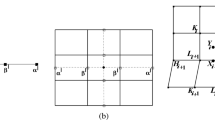Abstract
In this paper, we propose an efficient strategy for the construction of a family of ternary subdivision schemes with five parameters. These five parameters allow us to increase the choices when drawing and designing different models from the same initial control points. Moreover, by choosing appropriate values of parameters, we can get many existing ternary approximating subdivision schemes. Some of the existing ternary interpolatory and many new ternary approximating/interpolatory subdivision schemes with arbitrary order of regularities can also be obtained.
Similar content being viewed by others
References
Aslam, M., Mustafa, G., Ghaffar, A.: \((2n-1)\)-Point ternary approximating and interpolating subdivision schemes. J. Appl. Math. 2011, 12 (2011)
Chaikin, G.M.: An algorithm for high speed curve generation. Comput. Graph. Image Process. 3(4), 346–349 (1974)
Charina, M., Conti, C.: Polynomial reproduction of multivariate scalar subdivision schemes. J. Comput. Appl. Math. 240, 51–61 (2013)
Deslauriers, G., Dubuc, S.: Symmetric iterative interpolation processes. Constr. Approx. 5, 49–68 (1989)
Dyn, N., Levin, D., Micchelli, C.: Using parameter to increase smoothness of curves and surfaces generated by subdivision. Comput. Aided Geom. Des. 7, 129–140 (1990)
Ghaffar, A., Mustafa, G., Qin, K.: The 4-point \(a\)-ary approximating subdivision scheme. Open J. Appl. Sci. 3, 106–111 (2013)
Ghaffar, A., Mustafa, G.: A family of even-point ternary approximating schemes. Appl. Math. 2012, 14 (2012)
Ghaffar, A., Mustafa, G., Qin, K.: Unification and application of 3-point approximating subdivision schemes of varying arity. Open J. Appl. Sci. 2012, 48–52 (2012)
Ko, K.P., Lee, B.G., Yoon, G.J.: A ternary 4-point approximating subdivision scheme. Appl. Math. Comput. 190, 1563–1573 (2007)
Mustafa, G., Ghaffar, A., Khan, F.: The odd-point ternary approximating schemes. Am. J. Comput. Math. 1, 111–118 (2011)
Rehan, K., Siddiqi, S.S.: A family of ternary subdivision schemes for curve. Appl. Math. Comput. 270, 114–123 (2015)
Shen, L., Huang, Z.: A class of curve subdivision schemes with several parameters. Comput. Aided Geom. Des. Comput. Graph 19, 468–472 (2007)
Siddiqi, S.S., Rehan, K.: Ternary \(2N\)-point Lagrange subdivision schemes. Appl. Math. Comput. 249, 444–452 (2014)
Siddiqi, S.S., Younis, M.: Construction of ternary approximating subdivision schemes. UPB Sci. Bull. 76(1), 71–78 (2014)
Warren, J., Weimer, H.: Subdivision Method for Geometric Design. A Constructive Approach. Morgan Kaufmann Publishers, San Francisco (2001)
Zheng, H.C., Huang, S.P., Guo, F., Peng, G.H.: Designing multi-parameter curve subdivision schemes with high continuity. Appl. Math. Comput. 243, 197–208 (2014)
Zheng, H.C., Hu, M., Peng, G.: \(P\)-ary subdivision generalizing B-splines. Second Int. Conf. Comput. Electr. Eng. 2, 214–218 (2009)
Acknowledgements
This work is supported by NRPU (P. No. 3183) of HEC Pakistan.
Author information
Authors and Affiliations
Corresponding author
Appendices
Appendix A
1.1 A.1 Proof of Proposition 8
We shall prove it by mathematical induction on m. When \(m=1\),
The sum of the coefficients of the terms having the powers of z: 3p, \(3p+1\) and \(3p+2\) in b(z) are
and
Now assume that when \(m=k\), the result holds up i.e.
If we assume that \(4+2k=3p\), then we have
Now we shall prove that for \(m=k+1\), the result holds up.
Let \(m=k+1\), then
So the sum of the coefficients of the terms with the powers of z: 3p, \(3p+1\) and \(3p+2\) in b(z) are
Result holds up for \(m=k+1\). Therefore, the Proposition 8 holds up.
Appendix B
1.1 B.1 Proof of Proposition 9
We shall prove it by mathematical induction on m.
Let \(m=1\),
The generating polynomial of the difference scheme b(z) is corresponding to the following \(4 \times 4\) order difference matrix \(B_{1}\)
Eigenvalues of \(B_{1}\) are roots of the equation \(|B_{1}-\lambda I|=0\), where I is the \(4\times 4\) order unit matrix. Therefore we have
Adding all the columns in the second last column and expanding the resulting determinant according to the last column and then according to the first column, we get
Now extract the common factor \(\sum \nolimits _{i=0}^{4}\alpha _{i}-\lambda \) from the last column and then subtracting last row from the first row, we get
Therefore, eigenvalues of the difference matrix \(B_{1}\) are \(\alpha _{4}\), \(\alpha _{0}\), \(\sum \nolimits _{i=0}^{4}\alpha _{i}\) and \(-\alpha _{2}\).
Suppose that the result holds up for \(m=k\), we have to prove that the result also holds up for \(m=k+1\).
When \(m=k\), the generating polynomial b(z) of difference scheme is
If we assume that \(4+2k=3p\), then by the Proposition 8, we have
Let \(B_{k}\) of order \((3+2k) \times (3+2k)\) be the subdivision matrix corresponding to the generating polynomial of difference scheme \(b_{k}(z)\), then
where \(4+2k=3p\).
The eigenvalues of the matrix \(B_{k}\) are the roots of the characteristic equation \(|B_{k}-\lambda I|=0\).
When \(m=k+1\), the generating polynomial of the difference scheme become
Then subdivision matrix \(B_{k+1}\), which is corresponding to the generating polynomial of difference scheme \(b_{k+1}(z)\) is
Eigenvalues of matrix \(B_{k+1}\) are roots of the equation \(\left| B_{k+1}-\lambda I\right| =0\), therefore
Now we only need to show that the eigenvalues of the matrix \(B_{k+1}\) are the eigenvalues of the matrix \(B_{k}\) and \(3^{k}\sum \nolimits _{i=0}^{4}\alpha _{i}\). Adding all the columns in the last column and extracting the factor \(\sum \nolimits _{i=0}^{4+2k}\beta _{i}-\lambda =3^{k}\sum \nolimits _{i=0}^{4}\alpha _{i}-\lambda \), then all the elements of last columns will be 1. Now by subtracting each previous row from its consecutive next row, we get
Multiplying the both sides of the above matrix with the transformation matrix

we get

We can write the above matrices in the form of a determinant, therefore the eigenvalues of the matrix \(B_{k+1}\) are the eigenvalues of the matrix \(B_{k}\) and \(3^{k}\sum \nolimits _{i=0}^{4}\alpha _{i}\). Hence the Proposition 9 has proved.
Rights and permissions
About this article
Cite this article
Hameed, R., Mustafa, G. A family of univariate ternary subdivision schemes with 5 parameters. SeMA 75, 457–473 (2018). https://doi.org/10.1007/s40324-017-0144-y
Received:
Accepted:
Published:
Issue Date:
DOI: https://doi.org/10.1007/s40324-017-0144-y
Keywords
- Symmetric subdivision scheme
- Ternary subdivision scheme
- Quintic polynomial
- Generating polynomial
- Uniform convergence
- Joint spectral radius



